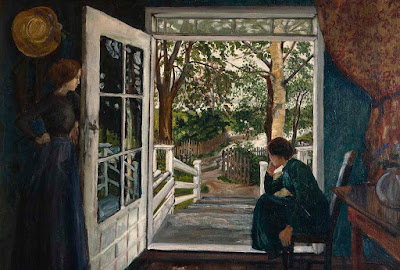By the Open Door (1911)
Midsummer Eve Bonfire (1915)
Astrup
(1880-1928) was one
of Norway’s most renowned landscape painters and printmakers, yet until now remained
completely unknown outside his native country.
Art history has favoured his contemporary, Edvard Munch, probably
because Munch left Norway to live and work in major art capitals of the time - Paris, Berlin, Munich - while Astrup, with the
exception of a one year residency in Paris (where he studied at the Académie
Colarossi and became influenced by the work of Maurice Dennis, Henri Rousseau
and Japanese woodcuts) he lived along the same fjord in North West Norway all
his life, only moving along the shoreline from one small village to another. In fact, this exhibition at the Dulwich Picture
Gallery is the first time his work has been seen in the United Kingdom. Astrup’s paintings of the surroundings in
which he lived transformed the Norwegian landscape into a mythical, living
entity. He was an exquisite painter and driven by the desire to create a ‘national
style’, Norwegian in feeling and subject matter, combining elements of realism
and a conscious naïveté. His luminous
landscapes appear to be simple, beautiful landscape studies but they are shot
through with an uneasy strangeness. The
son of a Lutheran pastor, Astrup’s visual language reference aspects of
Norwegian folklore as much as they do the Norwegian landscape and the
juxtaposition between Christian and Pagan, which the affected Astrup the man is
evident on the canvases of Astrup the artist.
Foxgloves (1920)
Two
paintings, A Morning in March (1920)
and The Parsonage (1928), demonstrates
this duality within Astrup’s oeuvre. A Morning in March depicts a fjord
shoreline under the snow and ice. A bare
tree rises up from the rocks’ edge. The
landscape is bleak, the tree almost troll-like in its appearance. In contrast, The Parsonage is a masterclass in realism. A beautifully accurate rendering of the
artist’s childhood home. One of my
personal favourites from the exhibition is A
Clear Night in June (1905-07), another view of the village of his
childhood. The finesse in the execution
of this still and calming landscape, with its balance of cool snowcapped
mountain and waterfall against the warm, yellow marigolds is riveting.
A Morning in March (1920)
The Parsonage (1928)
Unless you are
lucky enough to live within a stone’s throw from Dulwich Picture Gallery, the
venue can feel almost as remote as a Norwegian fjord to get to (it took me 2½ by
road, rail and tube). However, any and
all efforts to visit it will be more than rewarded for. The exhibition contains over 90 oil paintings
and prints, including works from private collections never exhibited before. The consistency in both his subject matter
and colour palette, ensure a vibrant and cohesive collection of paintings which
deserve to be seen by as many people as possible. Nikolai Astrup deserves the attention and it
is only a matter of time before his name becomes as known globally as Edvard Munch.
http://www.dulwichpicturegallery.org.uk/
http://www.dulwichpicturegallery.org.uk/
A Clear Night in June (1905-07)







No comments:
Post a Comment